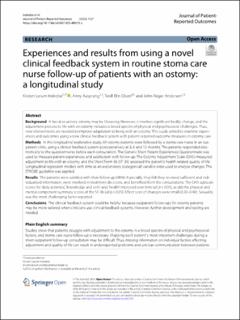| dc.contributor.author | Indrebø, Kirsten Lerum | |
| dc.contributor.author | Aasprang, Anny | |
| dc.contributor.author | Olsen, Torill Elin | |
| dc.contributor.author | Andersen, John Roger | |
| dc.date.accessioned | 2023-04-13T10:07:09Z | |
| dc.date.available | 2023-04-13T10:07:09Z | |
| dc.date.created | 2023-03-14T10:42:35Z | |
| dc.date.issued | 2023 | |
| dc.identifier.citation | Indrebø, K. L., Aasprang, A., Olsen, T. E., & Andersen, J. R. (2023). Experiences and results from using a novel clinical feedback system in routine stoma care nurse follow-up of patients with an ostomy: a longitudinal study. Journal of Patient-Reported Outcomes, 7(1):27. | en_US |
| dc.identifier.issn | 2509-8020 | |
| dc.identifier.uri | https://hdl.handle.net/11250/3062836 | |
| dc.description.abstract | Background
A faecal or urinary ostomy may be lifesaving. However, it involves significant bodily change, and the adjustment process to life with an ostomy includes a broad spectre of physical and psychosocial challenges. Thus, new interventions are needed to improve adaptation to living with an ostomy. This study aimed to examine experiences and outcomes using a new clinical feedback system with patient-reported outcome measures in ostomy care.
Methods
In this longitudinal explorative study, 69 ostomy patients were followed by a stoma care nurse in an outpatient clinic, using a clinical feedback system postoperatively at 3, 6 and 12 months. The patients responded electronically to the questionnaires before each consultation. The Generic Short Patient Experiences Questionnaire was used to measure patient experiences and satisfaction with follow-up. The Ostomy Adjustment Scale (OAS) measured adjustment to life with an ostomy, and the Short Form-36 (SF-36) assessed the patient's health-related quality of life. Longitudinal regression models with time as an explanatory (categorical) variable were used to analyse changes. The STROBE guideline was applied.
Results
The patients were satisfied with their follow-up (96%). Especially, they felt they received sufficient and individualised information, were involved in treatment decisions, and benefited from the consultations. The OAS subscale scores for 'daily activities', 'knowledge and skills' and 'health' improved over time (all p < 0.05), as did the physical and mental component summary scores of the SF-36 (all p < 0.05). Effect sizes of changes were small (0.20–0.40). Sexuality was the most challenging factor reported.
Conclusions
The clinical feedback system could be helpful because outpatient follow-ups for ostomy patients may be more tailored when clinicians use clinical feedback systems. However, further development and testing are needed. | en_US |
| dc.language.iso | eng | en_US |
| dc.publisher | Springer | en_US |
| dc.rights | Navngivelse 4.0 Internasjonal | * |
| dc.rights.uri | http://creativecommons.org/licenses/by/4.0/deed.no | * |
| dc.title | Experiences and results from using a novel clinical feedback system in routine stoma care nurse follow-up of patients with an ostomy: a longitudinal study | en_US |
| dc.type | Peer reviewed | en_US |
| dc.type | Journal article | en_US |
| dc.description.version | publishedVersion | en_US |
| dc.rights.holder | © The Author(s) 2023. | en_US |
| dc.source.volume | 7 | en_US |
| dc.source.journal | Journal of Patient-Reported Outcomes | en_US |
| dc.source.issue | 1 | en_US |
| dc.identifier.doi | 10.1186/s41687-023-00573-z | |
| dc.identifier.cristin | 2133726 | |
| dc.source.articlenumber | 27 | en_US |
| cristin.ispublished | true | |
| cristin.fulltext | original | |
| cristin.qualitycode | 1 | |

